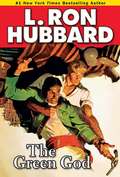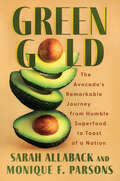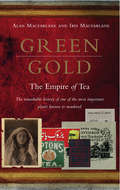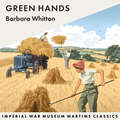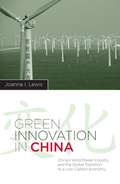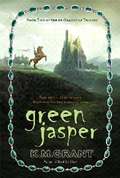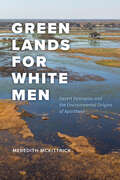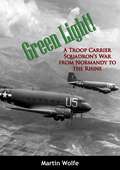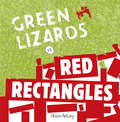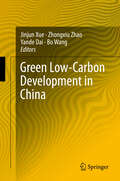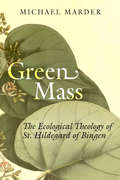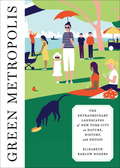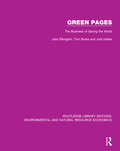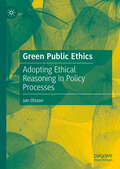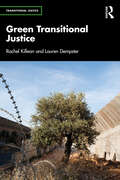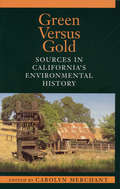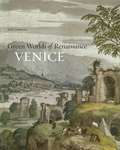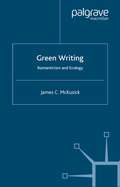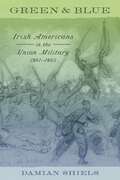- Table View
- List View
Green God, The
by L. Ron HubbardPrivate detective Sam Spade nearly died, several times over, chasing The Maltese Falcon. But what Spade faced in pursuit of the black bird was child's play compared to what Lieutenant Bill Mahone of Naval Intelligence endures when he sets out to find the Green God.He's tortured with knives, threatened with a slow, painful death, and buried alive. And then things get really nasty. The entire Chinese city of Tientsin is under siege from within--the streets filled with rioting, arson, mass looting and murder. And all because the city's sacred idol, the Green God, has gone missing. Mahone's convinced he knows who stole the deity of jade, diamonds and pearls. To retrieve it, though, he'll have to go undercover and underground. But he's walking a razor's edge--between worship and warfare, between a touch of heaven and a taste of bloody hell.As a young man, Hubbard visited Manchuria, where his closest friend headed up British intelligence in northern China. Hubbard gained a unique insight into the intelligence operations and spy-craft in the region as well as the criminal trade in sacred objects. It was on this experience that he based The Green God, which was his first professional sale, published in February, 1934--the beginning of a very remarkable and prolific writing career.Also includes the adventure Five Mex for a Million, in which an American Army captain, falsely accused of murder, finds himself taking on the Chinese government, a powerful Russian general, and a mysterious, unexpected passenger.
Green Gold: The Avocado's Remarkable Journey from Humble Superfood to Toast of a Nation
by Sarah Allaback Monique F. ParsonsA lively and engrossing cultural history of the avocado and the people who transformed it into an American obsession &“Whether you&’re a history buff or just enjoy a chip full of guacamole, you&’ll be thoroughly captivated . . . Green Gold is a well researched, captivating story.&” —Rick Bayless, James Beard Award-winning chef, author, and restaurateurThe avocado is the quintessential symbol of aspirational living, a ubiquitous agricultural favorite, and the driver of an $18 billion global industry. How did this regional Latin American staple become a star of Super Bowl ads and a byword for wellness? Documenting more than a century of cross-cultural cooperation, cutting-edge science, and savvy marketing, Green Gold tells the remarkable story of the fruit&’s rise to prominence as both a culinary and cultural juggernaut.Anchored by the story of two exceptional trees that stood out among hundreds of rivals, Green Gold is a spirited and often surprising behind-the-scenes look at how dedicated avocado enthusiasts in Mexico and California developed an ideal fruit to sell to the world. Navigating the Depression, two world wars, Mexican revolutions, violent drug lords, drought, and disease, these pioneers were driven by the avocado&’s potential to captivate the palates and hearts of consumers across the globe. Their efforts, inspired by the success of California citrus, launched today&’s lucrative industry and helped the avocado win a place among such supermarket staples as oranges and bananas.Set against the rise of Southern California as an economic and cultural powerhouse and featuring delightful recipes (including vintage versions of guacamole and avocado toast), Green Gold is an entertaining and far-ranging exploration of the avocado&’s journey to a central place in the American diet and global imagination.
Green Gold: The Empire of Tea
by Alan Macfarlane Iris MacfarlaneApart from water, tea is more widely consumed than any other food or drink. Tens of billions of cups are drunk every day. How and why has tea conquered the world? Tea was the first global product. It altered life-styles, religions, etiquette and aesthetics. It raised nations and shattered empires. Economies were changed out of all recognition. Diseases were thwarted by the magical drink and cities founded on it. The industrial revolution was fuelled by tea, sealing the fate of the modern world. Green Gold is a remarkable detective story of how an East Himalayan camellia bush became the world's favourite drink. Discover how the tea plant came to be transplanted onto every continent and relive the stories of the men and women whose lives were transformed out of all recognition through contact with the deceptively innocuous green leaf.
Green Hands
by Barbara WhittonIt is 1943, and a month into their service as Land Girls, Bee, Anne and Pauline are dispatched to a remote farm in rural Scotland. Here they are introduced to the realities of 'lending a hand on the land', as back-breaking work and inhospitable weather mean they struggle to keep their spirits high.Soon one of the girls falters, and Bee and Pauline receive a new posting to a Northumberland dairy farm. Detailing their friendship, daily struggles and romantic intrigues with a lightness of touch, Barbara Whitton's autobiographical novel paints a sometimes funny, sometimes bleak picture of time spent in the Women's Land Army during the Second World War."Tales from the home front are always more authentic when written from personal experience, as is the case here. Barbara Whitton evokes the highs and lows, joys and agonies of being a Land Girl in the Second World War." -- Julie Summers"Witty, warm and hugely endearing, Barbara Whitton s Green Hands is full of engaging characters, burgeoning friendships and pure hard-graft. A lovely novel for anyone interested in wartime Britain, it leaves the reader with renewed admiration for the indefatigable work of the Women s Land Army." --AJ Pearce(P)2020 Headline Publishing Group Limited
Green Innovation in China
by Joanna I LewisAs the greatest coal producing and consuming nation in the world, China would seem an unlikely haven for wind power. Yet the country now boasts a world-class industry that promises to make low-carbon technology more affordable and available to all. Conducting an empirical study of China's remarkable transition and the possibility of replicating their model elsewhere, Joanna I. Lewis adds greater depth to a theoretical understanding of China's technological innovation systems and the country's current and future role in a globalized economy.Lewis focuses on China's specific methods of international technology transfer, its forms of international cooperation and competition, and its implementation of effective policies that promoted the development of a home-grown industry. Just a decade ago, China claimed only a handful of operating wind turbines-all imported from Europe and the United States. Today, the country is the largest wind power market in the world, with turbines made almost exclusively in its own factories. Studying this shift reveals how China's political leaders have responded to domestic energy challenges and how they may confront climate change. The nation's ability to escalate its use of wind power also demonstrates China's ability to leapfrog to cleaner energy technologies-a path equally viable for other developing countries hoping to bypass gradual industrialization and the "technological lock-in" of hydrocarbon-intensive energy infrastructure. Though setbacks are possible, China could come to dominate global wind turbine sales, becoming a hub of technological innovation and a major instigator of low-carbon economic change.
Green Jasper (Book Two of the De Granville Trilogy)
by K. M. GrantIs it foolish to think that one boy and a blood red horse can save a fair maiden and the throne of England? Will and Gavin de Granville have come back from the crusade older, braver, and definitely wiser. Ellie has been longing for their return. But they've changed. And home is almost as dangerous as the war they've just left. The king is missing. The country is in turmoil. And some men would do anything for power. What will two brothers risk for the woman they both love and the king they have both sworn to protect and serve? In the second book of the de Granville trilogy, Will and Gavin find their family -- and all of England -- in serious peril.
Green Lands for White Men: Desert Dystopias and the Environmental Origins of Apartheid (science.culture)
by Meredith McKittrickHow an audacious environmental engineering plan fanned white settlers’ visions for South Africa, stoked mistrust in scientific experts, and gave rise to the Apartheid state. In 1918, South Africa’s climate seemed to be drying up. White farmers claimed that rainfall was dwindling, while nineteenth-century missionaries and explorers had found riverbeds, seashells, and other evidence of a verdant past deep in the Kalahari Desert. Government experts insisted, however, that the rains weren’t disappearing; the land, long susceptible to periodic drought, had been further degraded by settler farmers’ agricultural practices—an explanation that white South Africans rejected. So when the geologist Ernest Schwarz blamed the land itself, the farmers listened. Schwarz held that erosion and topography had created arid conditions, that rainfall was declining, and that agriculture was not to blame. As a solution, he proposed diverting two rivers to the Kalahari’s basins, creating a lush country where white South Africans could thrive. This plan, which became known as the Kalahari Thirstland Redemption Scheme, was rejected by most scientists. But it found support among white South Africans who worried that struggling farmers undermined an image of racial superiority. Green Lands for White Men explores how white agriculturalists in southern Africa grappled with a parched and changing terrain as they sought to consolidate control over a Black population. Meredith McKittrick’s timely history of the Redemption Scheme reveals the environment to have been central to South African understandings of race. While Schwarz’s plan was never implemented, it enjoyed sufficient support to prompt government research into its feasibility, and years of debate. McKittrick shows how white farmers rallied around a plan that represented their interests over those of the South African state and delves into the reasons behind this schism between expert opinion and public perception. This backlash against the predominant scientific view, McKittrick argues, displayed the depth of popular mistrust in an expanding scientific elite. A detailed look at the intersection of a settler society, climate change, white nationalism, and expert credibility, Green Lands for White Men examines the reverberations of a scheme that ultimately failed but influenced ideas about race and the environment in South Africa for decades to come.
Green Landscapes in the European City, 1750–2010 (Routledge Studies in Modern European History)
by Peter Clark Marjaana Niemi Catharina NolinGreen space is a fundamental concept for understanding modern and contemporary urban society, shedding light not only on the ecological development of cities but also societal relations, urban governance and planning processes. Closely linked to issues of environmental change, changing perceptions of nature, urban well-being and social integration, as well as city economic competitiveness and branding, it is an important element both in the internationalisation of European cities, and the forging of their distinctive communal identities. Building upon recent research on the history of green landscapes in the city in Europe and North America, this volume mirrors the burgeoning global attention to urban green space developments from city policy-makers and planners, architects, climatologists, ecologists, geographers and other social scientists. Taking case studies from Paris, London, Berlin, Helsinki, and other leading centres, the volume examines when, why, and how green landscapes evolved in major cities, and the extent to which they have been shaped by shared external forces as well as by distinctive and specific local needs. Quantifying green space trends in this way raises important issues of classification and categorisation of the different varieties of urban green space. While urban parks have received considerable coverage, many other smaller, less prestigious, spaces have been largely ignored. This volume argues that green landscapes can only be properly understood when the full range of spaces from parks to recreation grounds, housing areas, allotments and domestic gardens is taken into account. Adopting a broader approach to urban green space helps put European developments during the 19th and 20th centuries into a global perspective.
Green Leaf In Drought
by Isobel KuhnThis book tells the story of the Mathews family, who were trapped in China when the Communists outlawed Christianity. Through many hardships, Arthur, Widla, and their baby, Lilah, are tested. Their faith inspires.
Green Light!: A Troop Carrier Squadron’s War from Normandy to the Rhine
by Martin WolfeIn Green Light!, Martin Wolfe tells the story of another organization in an earlier war whose activities never received much publicity yet had a great impact on various combat operations. During World War II, the 81st Troop Carrier Squadron, as its name implies, carried and dropped paratroopers onto the battlefield, often in the face of heavy enemy fire. Despite sometimes heavy losses in this hazardous and demanding job, the 81st TCS never wavered.This book relates the exploits of the 81st, which mirror the combat experience of all World War II troop carrier units.
Green Lizards vs Red Rectangles: A story about war and peace
by Steve AntonyA brave and thought-provoking picture book about war and peace, from the creator of the much-loved Mr Panda series. The green lizards and the red rectangles are at war. No one can remember why, but they fight and fight... Until one day, a little red rectangle decides to speak up. Can lizards and rectangles find a way to overcome their differences and live peacefully together? Accessible for even the youngest readers, this is the perfect book to start conversations about learning to get along with each other. Steve Antony is the winner of the Evening Standard Oscar's First Book Prize. He's been nominated for the Kate Greenaway Medal and shortlisted for the Waterstones Children's Book Prize.
Green Low-Carbon Development in China
by Jinjun Xue Zhongxiu Zhao Yande Dai Bo WangThe book provides an in depth analyses of the experience and lessons in Chinese energy and emissions reductions policies in a climate change constrained scenario. As China emerges as the world second largest economy and first largest carbon emitter, the country is moving onto a low-carbon development path. Projections of medium and long term energy supply and demand scenarios are presented, based on variations on the energy supply structure, key energy consumption sectors and energy conservation policy innovation. Energy efficiency policies are evaluated based on lessons and experiences from case studies in different sectors, and policy innovations in terms of financial, legal and regulatory approaches to improve energy efficiency and reduce carbon emissions are proposed. The book includes the latest research findings of leading experts in energy policy and low-carbon economy from researchers, key think tanks and government officials in both China and the world.
Green Mass: The Ecological Theology of St. Hildegard of Bingen
by Michael MarderGreen Mass is a meditation on—and with—twelfth-century Christian mystic and polymath Saint Hildegard of Bingen. Attending to Hildegard's vegetal vision, which greens theological tradition and imbues plant life with spirit, philosopher Michael Marder uncovers a verdant mode of thinking. The book stages a fresh encounter between present-day and premodern concerns, ecology and theology, philosophy and mysticism, the material and the spiritual, in word and sound. Hildegard's lush notion of viriditas, the vegetal power of creation, is emblematic of her deeply entwined understanding of physical reality and spiritual elevation. From blossoming flora to burning desert, Marder plays with the symphonic multiplicity of meanings in her thought, listening to the resonances between the ardency of holy fire and the aridity of a world aflame. Across Hildegard's cosmos, we hear the anarchic proliferation of her ecological theology, in which both God and greening are circular, without beginning or end. Introduced with a foreword by philosopher Marcia Sá Cavalcante Schuback and accompanied by cellist Peter Schuback's musical movements, which echo both Hildegard's own compositions and key themes in each chapter of the book, this multifaceted work creates a resonance chamber, in which to discover the living world anew. The original compositions accompanying each chapter are available free for streaming and for download at www.sup.org/greenmass
Green Metropolis: The Extraordinary Landscapes of New York City as Nature, History, and Design
by Tony Hiss Elizabeth Barlow RogersElizabeth Barlow Rogers, the woman who launched the restoration of Central Park in the 1980s, now introduces us to seven remarkable green spaces in and around New York City, giving us the history--both natural and human--of how they have been transformed over time.Here we find: The greenbelt and nature refuge that runs along the spine of Staten Island on land once intended for a highway, where mushrooms can be gathered and, at the right moment, seventeen-year locusts viewed. Jamaica Bay, near John F. Kennedy International Airport, whose mosaic of fragile, endangered marshes has been preserved as a bird sanctuary on the Atlantic Flyway, full of egrets, terns, and horseshoe crabs. Inwood Hill, in upper Manhattan, whose forest once sheltered Native Americans and Revolutionary soldiers before it became a site for wealthy estates and subsequently a public park. The Central Park Ramble, an artfully designed wilderness in the middle of the city, with native and imported flora, magnificent rock outcrops, and numerous species of resident and migrating birds. Roosevelt Island, formerly Welfare Island, in the East River, where urban planners built a "new town in town" in the 1970s and whose southern tip is the dramatic setting for the Louis Kahn-designed memorial to Franklin Delano Roosevelt. Freshkills, the unusual twenty-two-hundred-acre park on Staten Island that is being created out of what was once the world's largest landfill. The High Line, in Manhattan's Chelsea and West Village neighborhoods, an aerial promenade built on an abandoned elevated rail spur with its native grasses and panoramic views of the Hudson River and the downtown cityscape.Full of the natural history of the parks along with interesting historical facts and interviews with caretakers, guides, local residents, guardians, and visitors, this beautifully illustrated book is a treasure trove of information about the varied and pleasurable green spaces that grace New York City.From the Hardcover edition.
Green Mountain Opium Eaters: A History of Early Addiction in Vermont
by Gary G. ShattuckThe green mountains, lush valleys and riotous fall colors of idyllic nineteenth-century Vermont masked a sinister underbelly. By 1900, the state was in the throes of a widespread opium epidemic that saw more than 3.3 million doses of the drug being distributed to inhabitants each and every month. Decades of infighting within the medical profession, complicit doctors and druggists, unrestricted access to opium and bogus patent medicines all contributed to the problem. Those conflicts were compounded by a hands-off legislature focused on prohibiting the consumption of alcohol. Historian Gary G. Shattuck traces this unusual aspect of Vermont’s past.
Green Pages: The Business of Saving the World (Routledge Library Editions: Environmental and Natural Resource Economics)
by John Elkington Tom Burke Julia HailesOriginally published in 1988. Europeans want a better environment. Increasingly, too, they are demanding the products, services, legislation and policies that will provide it. Green Pages reveals what Europe’s environmentalists plan to do next and how environmental pressures will threaten major markets – and at the same time opens up new opportunities for business, investment and employment. Green Pages is a fantastic reference source for green enterprise, and will be of interest to students of environmental economics.
Green Parrots: A War Surgeon's Diary
by Howard Zinn Gino StradaDesigned to look like toys, green parrots are small, winged cylinders roughly four inches long that flutter over lands devastated by war, but are, in fact, antipersonnel mines. This book introduces us to the endless destruction that the green parrots have spread throughout the world, and in so doing raises an urgent question: Is it legitimate to accept war as an inevitable prospect for current and future generations? After appearing in numerous languages since its initial publication in 1999, this English edition is particularly timely. The appendix of "Green Parrots" contains the complete text of the Universal Declaration of Human Rights, approved on December 10, 1948 by the General Assembly of the United Nations, which begins by proclaiming: "All human beings are born free and equal in dignity and rights. "
Green Public Ethics: Adopting Ethical Reasoning in Policy Processes
by Jan OlssonThis book argues that ethical reasoning should be adopted into policy processes in order to improve environmental regulations. It considers how public administrators and civil servants play key roles in policy making and implementation, and demonstrates how the inclusion of green public ethics at every stage of the policy process could drastically enhance sustainable development initiatives. Filling an important void in the literature on policymaking and environmental ethics, the book draws from empirical case studies to demonstrate how ‘green’ ethical reasoning can be utilised by practitioners and stakeholders in democratic governments. It will appeal to all those interested in public policy, public administration, philosophy and environmental studies.
Green Transitional Justice (Transitional Justice)
by Rachel Killean Lauren DempsterThis book rethinks the boundaries of transitional justice, urging scholars and practitioners to confront the often-overlooked nexus between mass violence and ecological harm.Through an in-depth analysis of the field’s limitations – such as its anthropocentric legalism, neocolonial practices, and alignment with neoliberalism – the book critiques the historical marginalisation of Nature in transitional justice discourse and practice. It argues that ignoring environmental harm not only undermines the possibility of holistic justice but also perpetuates structural violence and inequality. In response, the book sketches a ‘greener’ transitional justice, integrating principles from environmental justice, Indigenous knowledge systems, and ecocentric perspectives. It explores the possibilities of recognising Nature as a victim of mass violence, adapting existing mechanisms to incorporate environmental harm, and fostering transformative approaches premised on the interdependence of human and ecological well-being.This book is written for students, researchers, and practitioners of transitional justice and fields related to conflict transformation, peacebuilding, environmental protection, and development.
Green Versus Gold: Sources In California's Environmental History
by Carolyn MerchantWhile the state of California remains one of the most striking and varied landscapes in the world, it has experienced monumental changes since European settlers first set foot there. The past two centuries have witnessed an ongoing struggle between environment and economy, nature and humanity that has left an indelible mark on the region.Green Versus Gold provides a compelling look at California's environmental history from its Native American past to conflicts and movements of recent decades. Acclaimed environmental historian Carolyn Merchant has brought together a vast storehouse of primary sources and interpretive essays to create a comprehensive picture of the history of ecological and human interactions in one of the nation's most diverse and resource-rich states.For each chapter, Merchant has selected original documents that give readers an eyewitness account of specific environments and periods, along with essays from leading historians, geographers, scientists, and other experts that provide context and analysis for the documents. In addition, she presents a list of further readings of both primary and secondary sources. Among other topics, chapters examine:California's natural environment and Native American lands the Spanish and Russian frontiers environmental impacts of the gold rush the transformation of forests and rangelands agriculture and irrigation cities and urban issues the rise of environmental science and contemporary environmental movement.Merchant's informed and well-chosen selections present a unique view of decades of environmental change and controversy. Historians, educators, environmentalists, writers, students, scientists, policy makers, and others will find the book an enlightening and important contribution to the debate over our nation's environmental history.
Green Victorians
by Fredrik Albritton Jonsson Vicky AlbrittonFrom Henry David Thoreau to Bill McKibben, critics and philosophers have long sought to demonstrate how a sufficient life--one without constant, environmentally damaging growth--might still be rich and satisfying. Yet one crucial episode in the history of sufficiency has been largely forgotten. Green Victorians tells the story of a circle of men and women in the English Lake District who attempted to create a new kind of economy, turning their backs on Victorian consumer society in order to live a life dependent not on material abundance and social prestige but on artful simplicity and the bonds of community. At the center of their social experiment was the charismatic art critic and political economist John Ruskin. Albritton and Albritton Jonsson show how Ruskin's followers turned his theory into practice in a series of ambitious local projects ranging from hand spinning and woodworking to gardening, archaeology, and pedagogy. This is a lively yet unsettling story, for there was a dark side to Ruskin's community as well--racist thinking, paternalism, and technophobia. Richly illustrated, Green Victorians breaks new ground, connecting the ideas and practices of Ruskin's utopian community with the problems of ethical consumption then and now.
Green Worlds of Renaissance Venice
by Jodi CranstonFrom celebrated gardens in private villas to the paintings and sculptures that adorned palace interiors, Venetians in the sixteenth century conceived of their marine city as dotted with actual and imaginary green spaces. This volume examines how and why this pastoral vision of Venice developed.Drawing on a variety of primary sources ranging from visual art to literary texts, performances, and urban plans, Jodi Cranston shows how Venetians lived the pastoral in urban Venice. She describes how they created green spaces and enacted pastoral situations through poetic conversations and theatrical performances in lagoon gardens; discusses the island utopias found, invented, and mapped in distant seas; and explores the visual art that facilitated the experience of inhabiting verdant landscapes. Though the greening of Venice was relatively short lived, Cranston shows how the phenomenon had a lasting impact on how other cities, including Paris and London, developed their self-images and how later writers and artists understood and adapted the pastoral mode.Incorporating approaches from eco-criticism and anthropology, Green Worlds of Renaissance Venice greatly informs our understanding of the origins and development of the pastoral in art history and literature as well as the culture of sixteenth-century Venice. It will appeal to scholars and enthusiasts of sixteenth-century history and culture, the history of urban landscapes, and Italian art.
Green Worlds of Renaissance Venice
by Jodi CranstonFrom celebrated gardens in private villas to the paintings and sculptures that adorned palace interiors, Venetians in the sixteenth century conceived of their marine city as dotted with actual and imaginary green spaces. This volume examines how and why this pastoral vision of Venice developed.Drawing on a variety of primary sources ranging from visual art to literary texts, performances, and urban plans, Jodi Cranston shows how Venetians lived the pastoral in urban Venice. She describes how they created green spaces and enacted pastoral situations through poetic conversations and theatrical performances in lagoon gardens; discusses the island utopias found, invented, and mapped in distant seas; and explores the visual art that facilitated the experience of inhabiting verdant landscapes. Though the greening of Venice was relatively short lived, Cranston shows how the phenomenon had a lasting impact on how other cities, including Paris and London, developed their self-images and how later writers and artists understood and adapted the pastoral mode.Incorporating approaches from eco-criticism and anthropology, Green Worlds of Renaissance Venice greatly informs our understanding of the origins and development of the pastoral in art history and literature as well as the culture of sixteenth-century Venice. It will appeal to scholars and enthusiasts of sixteenth-century history and culture, the history of urban landscapes, and Italian art.
Green Writing: Romanticism and Ecology
by James McKusickThis book describes the emergence of ecological understanding among the English Romantic poets, arguing that this new holistic paradigm offered a conceptual and ideological basis for American environmentalism. Coleridge, Wordsworth, Blake, John Clare, and Mary Shelley all contributed to the fundamental ideas and core values of the modern environmental movement; their vital influence was openly acknowledged by Emerson, Thoreau, John Muir, and Mary Austin. By revealing hitherto unsuspected links between English and American nature writers, this book elucidates the Romantic origins of American environmentalism.
Green and Blue: Irish Americans in the Union Military, 1861–1865 (Conflicting Worlds: New Dimensions of the American Civil War)
by Damian ShielsDamian Shiels’s Green and Blue explores Irish American service in the United States military by analyzing the written correspondence of ordinary rank-and-file soldiers drawn from across the Union’s armed forces. Using a vast and largely untapped collection of letters penned by Irish American combatants to their families during the war, Shiels explains how these enlisted men navigated their duties from multiple perspectives, including how they adapted to and experienced military life, how they engaged with their faith, and how they interacted with the home front. Green and Blue offers the most detailed and intimate picture yet of Irish Americans’ service in the United States military during the Civil War.
